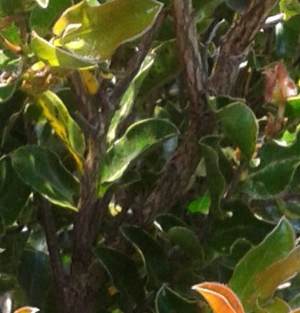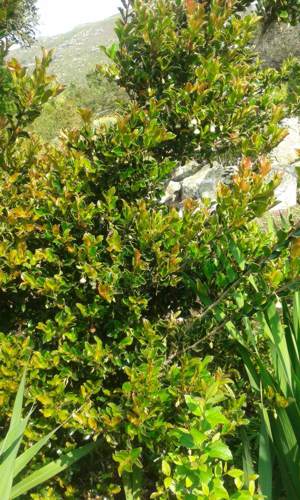Diospyros scabrida var. cordata
Diospyros scabrida (Harv. ex Hiern) De Winter var. cordata (E.Mey. ex A.DC.) De Winter
Family: Ebenaceae
Common names: Hard-leaved monkey plum; blinkblaar,hardeblaartolbos (Afr.)
SA Tree No: 608
Introduction
This lovely little tree has three outstanding features to recommend it; its compact growth habit, its gorgeous glossy foliage and its unusual balloon fruit capsules. It is also versatile and adaptable, a real asset to any garden.

Description
Description
A dense, evergreen shrub, 2 - 3m tall, with smooth, dark grey bark. Young branches are densely covered with rough hairs.

The flat, hard, leathery leaves are borne in an alternate arrangement. They are the best feature of this plant being glossy dark green with some hairs above, much paler and densely hairy below. Young leaves are distinguishable by the coppery hairs -- adding an attractive colour tone to the plant's overall appearance.

Creamy-white, sweetly scented flowers, single or in small clusters, occur from spring through to summer (October to March). Interestingly, the male and female flowers are borne on different plants. The fruits, which ripen in autumn (May to June), are oval, red, fleshy berries, almost entirely enclosed in inflated, bladder-like capsules that are formed from the persistent flower calyx.

Conservation Status
Status
Listed with the threatened status of LC, which is of Least Concern.
Distribution and habitat
Distribution description
The family Ebenaceae has only two genera and ± 500 species which occur throughout the tropics and subtropics. In southern Africa both the genera, Euclea and Diospyros are represented. The genus Diospyros has ± 475 species in tropical, subtropical and temperate areas (America ± 80, Africa ± 94, Madagascar ± 100, Asia ± 200) and in southern Africa ± 20 species and several subspecies occur, spread throughout Namibia, Botswana, Northern Province, North-West, Gauteng, Mpumalanga, Swaziland, Free State, KwaZulu-Natal, Lesotho and the Northern, Western and Eastern Cape. Diospyros scabrida var. cordata is mainly confined to the Eastern Cape and occurs naturally in thicket growth and on rocky outcrops.
Even though it is in some cases difficult to distinguish the var. cordata from the var. scabrida, the former is a more common plant and a more visible constituent of the vegetation where it occurs, than the rarer Diospyros scabrida var. scabrida, which mainly occurs in KwaZulu-Natal. The latter also has elliptic, 30 - 80mm long leaves, rather than ovate leaves that rarely exceed 30mm.
It can also easily be confused with Diospyros whyteana when not in flower or fruit but habitat and distribution differ, also in that species, the fruit capsule lobes are joined to completely enclose the fruit.
Derivation of name and historical aspects
History
Diospyros was so named by Linnaeus in 1753 and is derived from the Greek, Diospyros, meaning 'celestial pear' referring to those species with delectable fruits; unfortunately none of the South African species are delicious although a few have a pleasant enough taste. The specific epithet scabrida means 'rough', referring to the hairs on the leaves and stems.
Ecology
Ecology
The fruit is eaten by birds; and the foliage is browed by game and stock animals. The flowers attract insects. Plants are dioecious, either male or female.
Uses
Use
The fruits are edible but are somewhat bitter, and so not very tasty. Extracts of various parts of the plants are believed to have antibiotic properties. The roots are also used medicinally by the local people.

Growing Diospyros scabrida var. cordata
Grow
This decorative plant with its neat growth habit, glossy dark green leaves and red berries in capsules, is an excellent plant for any garden. It attracts birds to the garden and the sweetly scented flowers are an added delight. It is well suited to bonsai and, because of its size and habit, also as a rockery plant, as it is so hardy. It makes a lovely container plant and would feature well planted in a small garden where space is limited. Waterwise and low maintenance, plant in a sunny spot in well-drained, frequently composted soil. As the male and female flowers occur on different plants, one of each plant is needed to ensure pollination and therefore seed formation.
Diospyros is relatively slow growing and can be cultivated from seed, which should first be scarified before sowing, for better germination results. Sow 1-2mm deep in sandy, well-drained, potting soil. Fresh seed germinates readily in four to eight weeks. After germination the seedlings should be potted up into individual bags/pots as soon as the first pair of true leaves appear. It may also seed itself in the garden, where the seedlings may also be dug up and transplanted into small pots. It can also be propagated by cuttings.
References
- Coates Palgrave, K. 1977 . Trees of southern Africa . Struik, Cape Town.
- Foden, W. & Potter, L. 2005. Diospyros scabrida (Harv. ex Hiern) De Winter var. cordata (E.Mey. ex A.DC.) De Winter. National Assessment: Red List of South African Plants version 2014.1. Accessed on 2014/09/11
- Leistner, O.A. (ed.). 2000. Seeds plants of southern Africa: families and genera. Strelitzia 10. National Botanical Institute, Pretoria.
- Van Wyk, B. & Gericke, N. 2000. People's plants: a guide to useful plants of southern Africa. Briza Publications, Pretoria.
Credits
Cherise Viljoen
Kirstenbosch National Botanical Gardens
September 2014
Plant Attributes:
Plant Type: Shrub, Tree
SA Distribution: Eastern Cape, KwaZulu-Natal
Soil type:
Flowering season:
PH:
Flower colour: Cream
Aspect:
Gardening skill: Average
Special Features:
Horticultural zones









Rate this article
Article well written and informative
Rate this plant
Is this an interesting plant?
Login to add your Comment
Back to topNot registered yet? Click here to register.